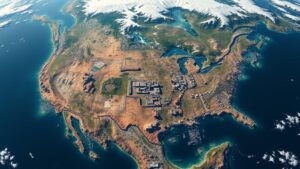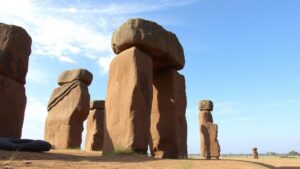Exploring the sparkling beauty of Canada’s Athabasca Glacier in the Columbia Icefield.
Exploring the Sparkling Beauty of Canada’s Athabasca Glacier in the Columbia Icefield
The Athabasca Glacier, nestled within the breathtaking expanse of the Columbia Icefield in Jasper National Park, Alberta, offers visitors a unique glimpse into the powerful forces of nature. This massive glacier, which is a vital part of the North American continents largest icefield, presents not only stunning scenery but also fascinating geological and environmental insights.
Geological Significance of the Athabasca Glacier
The Athabasca Glacier is one of the most accessible glaciers in North America, extending approximately 6 kilometers (3.7 miles) from its source in the Columbia Icefield. It is a major outlet glacier of the icefield, which spans an impressive area of over 325 square kilometers (125 square miles). This glacier is a dynamic feature that has been constantly changing, retreating significantly over the past century due to rising global temperatures.
Geologically, the Athabasca Glacier is fascinating. It is a part of the Cordilleran Ice Sheet, which covered much of western Canada during the last ice age. Today, it serves not only as a remnant of this ancient ice mass but also as a poignant indicator of climate change. According to the University of Alberta, the glacier has receded over 1.5 kilometers (0.93 miles) since the early 1900s.
Visiting the Athabasca Glacier
For those wishing to explore the glacier, various guided tour options are available. The Columbia Icefield Adventure is a popular choice that combines a ride on the Ice Explorer, a robust vehicle built to travel on ice, with a visit to the Glacier Skywalk, a glass-bottom observation platform that provides awe-inspiring views of the surrounding landscape.
- Location: The glacier is easily accessible from the Icefields Parkway, an iconic drive that runs between Jasper and Banff.
- Best Time to Visit: The summer months of June through September are ideal for visiting due to milder weather conditions.
The Experience of Walking on Ice
Stepping onto the glacier itself is an unforgettable experience. Visitors are often struck by the vivid blue hues of the ice, a result of the way light interacts with the dense ice layers. A typical journey on the glacier includes a hike led by experienced guides who share insights about the glacial environment and its changing dynamics.
Walking the glacier gives participants firsthand experience with crevasses, ice formations, and glacial meltwater. The melting water forms streams that flow down from the glacier, reminding visitors of the impacts of climate change. Studies indicate that glaciers in the Canadian Rockies could lose up to 70% of their mass by 2100 if current climate trends continue.
Cultural and Ecological Importance
The Athabasca Glacier is not only a natural wonder but also holds cultural significance for the Indigenous peoples of the region. For centuries, the glaciers and mountains of the Rockies have been part of their heritage and traditions. Understanding the cultural context offers deeper insight into the land and its past.
Ecologically, the glacier is an integral part of the local watershed. Glacial meltwater is essential for river systems that support wildlife and human needs. But, the rapid melting of glaciers raises concerns regarding water availability for future generations, exacerbating issues related to water security.
Conclusion: The Future of the Athabasca Glacier
As climate change continues to impact the environment, the Athabasca Glacier serves as a cautionary tale about the fragility of our planet. Its retreat not only alters the stunning landscape but also affects ecological balance and water resources. Visitors to this magnificent glacier leave with not just memories of its beauty but also a greater awareness of the environmental challenges facing our world.
In summary, the Athabasca Glacier is a must-visit destination for those seeking to appreciate the natural beauty of Canada while gaining insight into important ecological issues. By understanding and advocating for the preservation of such natural wonders, we can contribute to the ongoing discourse surrounding climate change and its global effects.


